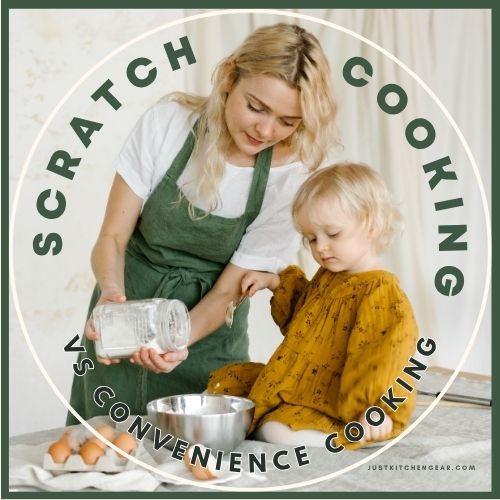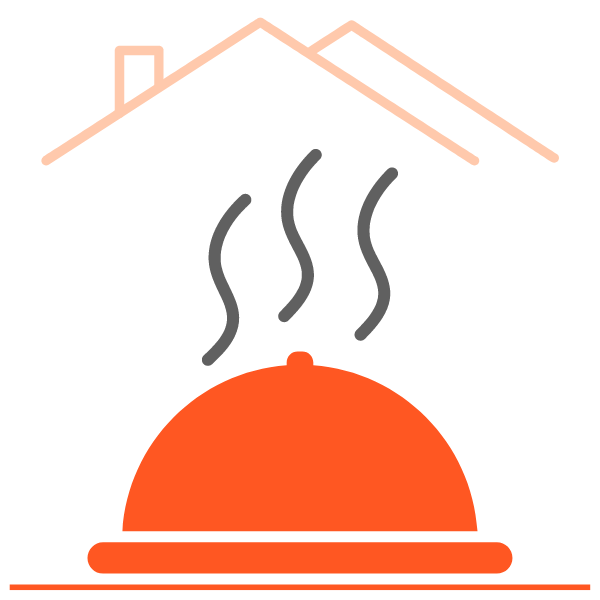*This post may contain affiliate links for which I earn commissions.*

Modern kitchens often blend elements of both worlds. One night you might simmer a homemade stew, the next you may toss a frozen pizza in the oven. But have you ever wondered: what’s the real difference between cooking from scratch vs convenience cooking?
Understanding this difference helps you make more informed choices for your health, budget, and even your culinary enjoyment. In this post, I want to break it down so you can see the differences and the benefits when you use whole foods and fresh ingredients.
What Does Cooking from Scratch Mean?
Cooking from scratch means preparing meals using whole or minimally processed ingredients. It’s about preparing dishes yourself rather than relying on pre-packaged, ready-made products. For example, instead of buying a ready meal of cottage pie, you make your own from fresh mince, carrots, celery, tomatoes and potatoes.
Other examples include:
- Chopping fresh vegetables, garlic and ginger for a stir-fry
- Making peppercorn sauce with onions, freshly ground peppercorns, mushrooms and cream vs opening a packet product
- Simmering a pasta sauce from fresh tomatoes, garlic, and herbs vs buying a jar of bolognese pasta sauce.
Scratch cooking, therefore, gives you control over what goes into your meals—flavour, freshness, and nutrition are in your hands.
What Is Convenience Cooking?
Convenience cooking leans on ready-made or processed foods to save time and effort. It doesn’t mean you’re not cooking; it just means some of the work has been done for you.
A few examples would be:
- Using jarred sauces instead of making your own.
- Baking with a boxed cake mix, margarine, and reformulated potato snacks
- Heating a microwave-ready meal, chicken nuggets
- Buying packet sauces, mass-produced bread, and breakfast cereals
The appeal is obvious: speed, simplicity, and less cleanup.
Scratch Cooking vs. Convenience Cooking: Key Differences
Here’s a simple side-by-side comparison:
| Aspect | Cooking from Scratch | Convenience Cooking |
|---|---|---|
| Ingredients | Whole foods, fresh produce, raw staples | Pre-prepared, packaged items |
| Nutrition | Fewer additives, healthier balance | many ultra-processed foods have no meaningful nutrition |
| Taste | Hidden salt, sugar, and preservatives | Many ultra-processed foods have no meaningful nutrition |
| Cost | Usually cheaper per portion | Higher cost due to packaging & processing |
| Time/Effort | More prep, cooking, and cleanup | Quick and easy, minimal prep |
When Convenience Cooking Has Its Place
It’s important to be realistic: convenience cooking isn’t always bad. Life is busy, and sometimes you need shortcuts.
- A frozen meal can save you after a long day.
- Pre-cut vegetables can help you get more greens on the table.
- A store-bought rotisserie chicken can be transformed into a variety of dishes, including soup, salads, and sandwiches.
Think of it as semi-homemade cooking, where a mix of convenience and fresh ingredients keeps you on track.
Why Cooking from Scratch Matters More Often
While convenience has its benefits, cooking from scratch offers long-term advantages that are hard to beat:
- Healthier meals – with fewer additives.
- Better value for money – whole ingredients stretch further.
- Superior taste – fresh herbs and spices can transform a dish.
- Cooking confidence – the more you cook, the better and quicker you get.
- Family connection – homemade meals often bring people together.
Scratch cooking is about more than just food; it’s a lifestyle that values real ingredients and mindful eating.
How to Transition Toward More Scratch Cooking
If convenience meals dominate your kitchen right now, don’t worry. You don’t have to change overnight. Small steps make a difference.
- Start with easy swaps: make your own salad dressing, cook rice instead of using microwave packets, or bake a simple loaf of bread.
- Use time-saving gadgets: a good food processor, slow cooker, or sharp knife makes scratch cooking faster and easier.
- Batch cooking and meal prep: cooking larger portions at once and freezing the excess allows you to have homemade convenience meals ready for the week.
Final Thoughts
The difference between cooking from scratch and convenience cooking comes down to control vs. ease. Convenience foods offer speed and simplicity, but cooking from scratch gives you fresher flavours, healthier meals, and a deeper connection to your food.
You don’t need to give up convenience completely; just try to make scratch cooking the foundation of your kitchen. Over time, those small changes add up to big benefits.
